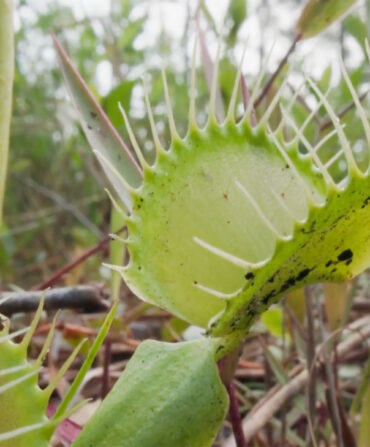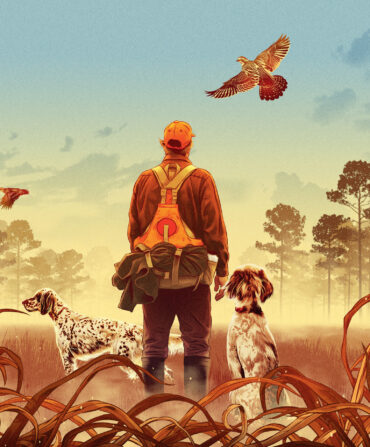Sporting South
An Arkansas Hunting Lodge That’s Changing the Game
For Jonathan Wilkins, the trips he organizes through his Black Duck Revival in Arkansas aren’t about guarded spots, bragging rights, or limiting out on game. They’re about giving everyone a taste of the hunt
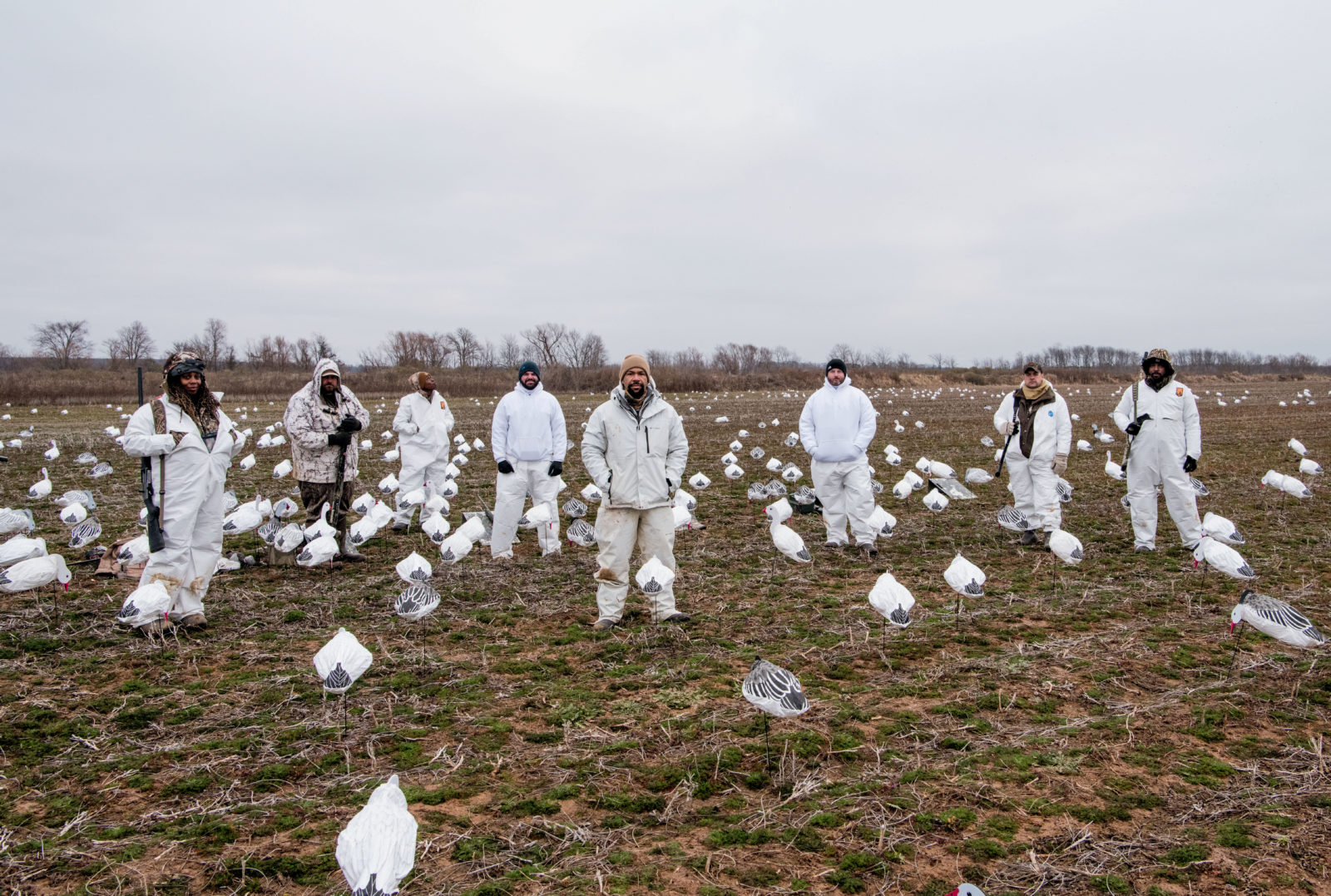
Photo: Andrew Hyslop
The weekend’s participants in the field.
We arise in the yawning hours before the dawn. Still, when we reach the field at 5:00 a.m., a crew of local outfitters have already been there for an hour and are only halfway through placing a spread of three thousand decoys meant to appear as a riotous flock of feeding snow geese. We join them in completing the carefully planned setup, spending another hour stabbing wire decoy bases into half-frozen mud until a mix of white nylon socks stand gently rippling among flat plastic goose silhouettes. My only frame of reference the relative paucity of a spread of sixty bobbing sea ducks or a jerk string of mallards floating among timber, I half assumed Jonathan Wilkins of Black Duck Revival was exaggerating when he told me the scope of a snow goose decoy field. Twelve hours later, slogging through the sticky corduroy of the field to retrieve the decoys, I believed. Wilkins is a man so deeply knowledgeable about so many passions, on first meeting you might assume he too is an exaggeration, an image. But “authentic” is a word that emerges repeatedly in almost any conversation with Wilkins, and it describes him, and what he is doing with Black Duck Revival, perfectly.
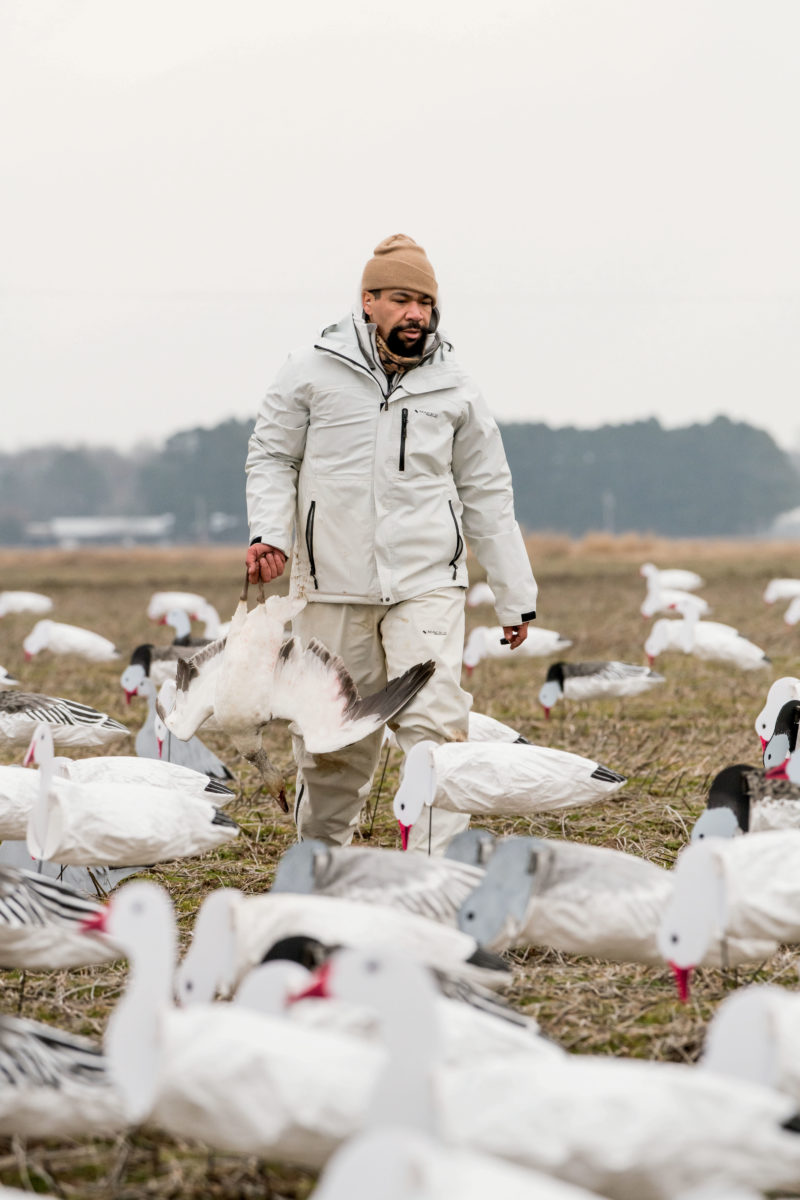
Photo: Andrew Hyslop
Wilkins with a snow goose amid a field of decoys.
Hunting is a tradition on the wane. Modern convenience, countless evanescent escapes from reality, and perceptions of what it means to be a hunter are discernibly throttling a pursuit fundamental on the North American continent since the first Paleolithic humans arrived. Those perceptions of hunting are not without basis. The latest U.S. Fish & Wildlife Service national survey, conducted in 2016, revealed that American hunters are 97 percent white, 90 percent male, and 60 percent older than forty-five. Given that status quo, Wilkins, a biracial graduate of a private liberal arts college with an eclectic assemblage of tattoos scrolling up his arms, makes an unlikely ambassador for a culture of which he is a decidedly atypical member.
Growing up in St. Louis, Wilkins was not raised in the woods, or even allowed a water gun until he was ten years old. He was twenty-seven on the morning in 2010 when he climbed into an Arkansas deer stand with a compound bow and shot a whitetail he nicknamed Bruce Springsteen because it was the boss of the woods. After he stopped shaking, he called the friend who had introduced him to hunting to help him recover the deer. His friend obliged before rushing off to be in a wedding party. Such are hunters. While eating venison and mashed potatoes with his wife, Marianne, and his friend that night, Wilkins realized hunting “isn’t insurmountable,” that it offers a path to the authentic life he is now called to offer to others. Thus has a group of six hunters of very different backgrounds gathered in his seasonal home base of Brinkley, Arkansas, all but one of us new to the pursuit of snow geese.
Like everyone else in Brinkley during the season, Jonathan Wilkins lives for waterfowl. Specifically, at 728 North New York Avenue, where a simple sign in black letters reads, BLACK DUCK REVIVAL, BRINKLEY, AR, EST. 2018. Next door, the yard of a freshly renovated house bears a similar sign proclaiming it BLACK DUCK BUNGALOW. Wilkins says he chose the name Black Duck Revival as a tongue-in-cheek nod to the reality that he is a Black man in a largely white space, as well as to acknowledge the main building’s history as a house of worship. But the primary meaning references his effort to reawaken interest among people, especially Black Americans, in engaging with the land and skills that afford self-reliance.
Before Jonathan and Marianne purchased the building in 2017, what had been the Heartline Christian Fellowship church died the slow death of small towns, and it had sat empty for three years. They gutted and rebuilt the interior themselves; enclosed what is now the backyard firepit, bar, and hunting education space with a new fence; and gave it a fresh coat of paint. Wilkins, who lives in Little Rock, initially saw the space as a place to overnight while hunting some of the best public waterfowl areas in America. But as he tore out walls and fixtures, he saw the bones of the building and, more important, heard its heart and soul. Things of the spirit will not be denied. That spirit led Wilkins to create a uniquely welcoming space where a hunter who isn’t exactly like the majority might welcome others similarly hindered by a lack of experience, a lack of an avenue to the field, or a lack of sense of belonging. Today, Black Duck Revival is a place where a man who rejects the title “guide” for “hunting educator and facilitator” can help anyone looking to learn about the natural world and their place within it. It’s where Wilkins works on being, as he says, “the best version of myself. Empathetic. Kind. I want to listen to people. I want to contribute to the expansion of human potential. That’s an aspirational goal. I want respect and for people to see me as a person willing to grow, to change, to adjust. I want to be a thoughtful person who puts good in the world.”
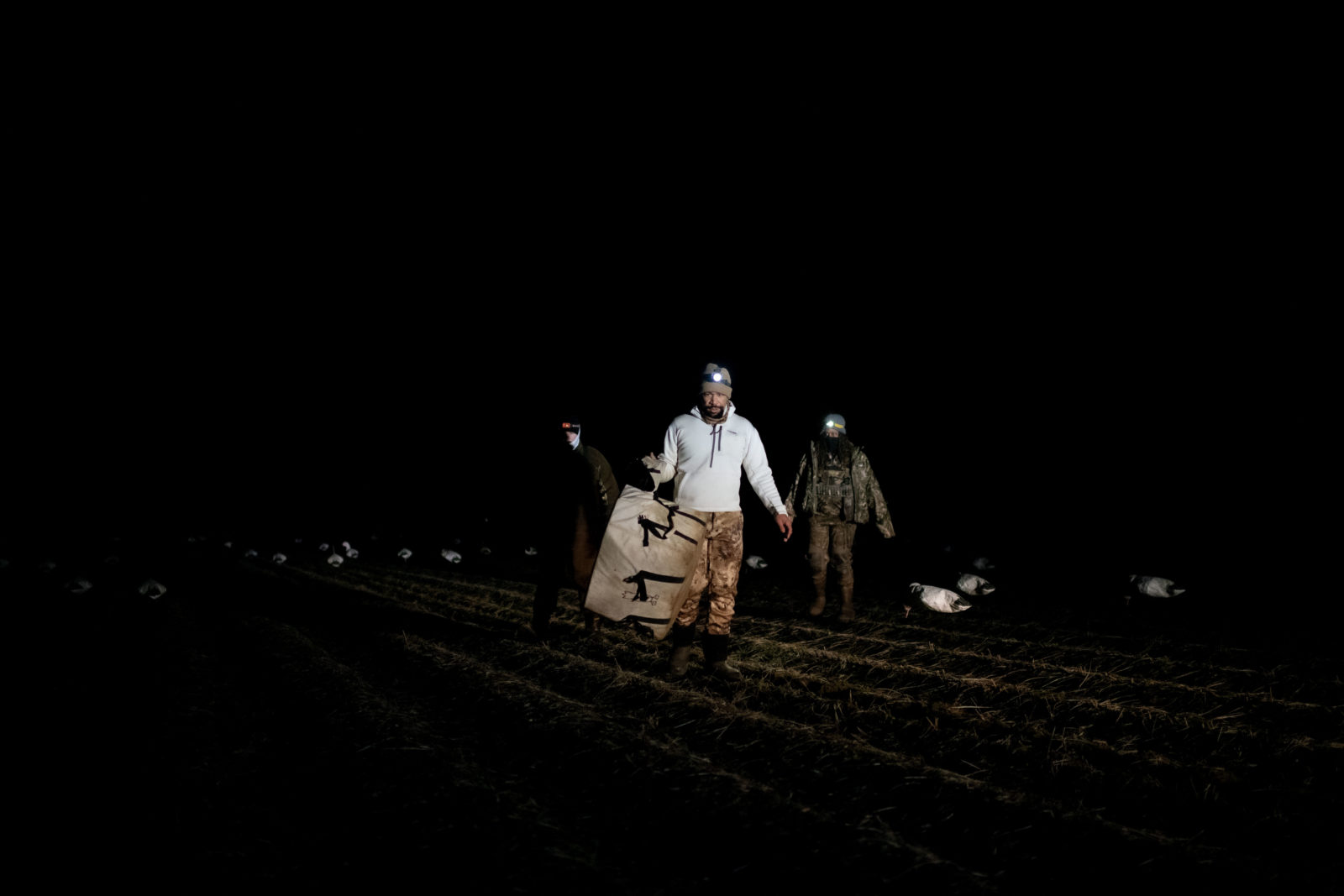
Photo: Andrew Hyslop
Wilkins and participants set out the last of the decoys before sunrise.
Wilkins laughingly calls himself a “humanities dude,” which seems an apt enough description though hardly one that naturally leads to Brinkley. After college, he spent time as a touring musician, working the manual labor jobs that supplement that life, and then farming, raising, and cooking high-end bar food for Little Rock’s famous White Water Tavern. With hunters arriving in a few hours, Wilkins cooks while he speaks. He regards food as history, and there is a purposefulness behind what he serves his hunters. “Tomorrow night we’re eating a raccoon I trapped,” he says. “There’s a tradition of African American hunters eating nocturnal animals because during slavery they were allowed to hunt to supplement the larder because it was cheaper for the landowner. But they could only hunt at night, after the day’s work was finished, so…possums and raccoons.” Wilkins emphasizes “acting with intention” in every facet of life, and the flavor profile of braised raccoon over sweet-potato-stuffed tortellini in béchamel with crispy collard garnish purposefully hearkens back to the antebellum South and further, to West Africa.
A conversation with Wilkins has a specific pacing and lingo. Words like “rad” pop up alongside “erudite” and “structural inequities.” “Man” appears regularly, usually preceding a particularly thoughtful assertion. Sentences that begin with “Man, the thing is…” or “Man, what a lot of people don’t realize is…” end with “…if I’m asking people to listen and consider and let me be heard, it is imperative that I’m offering that same thing to others, that in everyday life I’m offering grace.” Pausing to fuss over an aromatic riff on gumbo z’herbes, made with collard, mustard, and turnip greens complementing pigs’ feet, turkey tail, ham hock, and snow goose gizzards and hearts, he turns to literature. “Man, maybe it sounds unrefined or whatever, but I’ve always loved Louis L’Amour. That’s a Renaissance man! He panned for gold, boxed Golden Gloves, served in the merchant marine—he sought knowledge! He consumed books! I prefer pages. I mean, maybe that’s silly when you have the Library of Alexandria times infinity in your pocket, but…” He turns away to chop greens, then stops, looks through a window covered in multicolored film as Marianne’s ode to the stained-glass history of the building, then turns back and says, “I’ve always thought the saddest thing is to only be able to do one thing.”
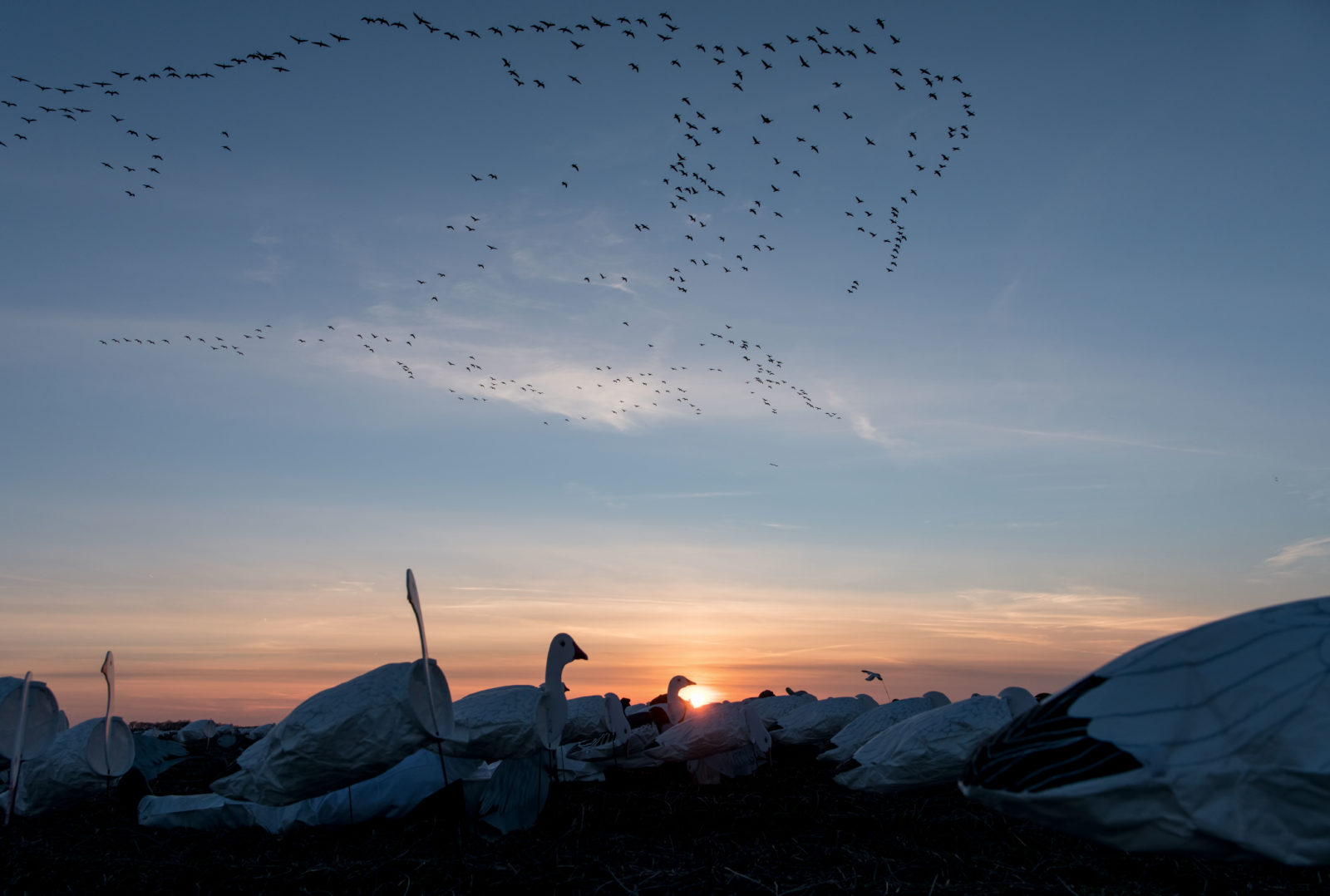
Photo: Andrew Hyslop
Geese flying at daybreak.
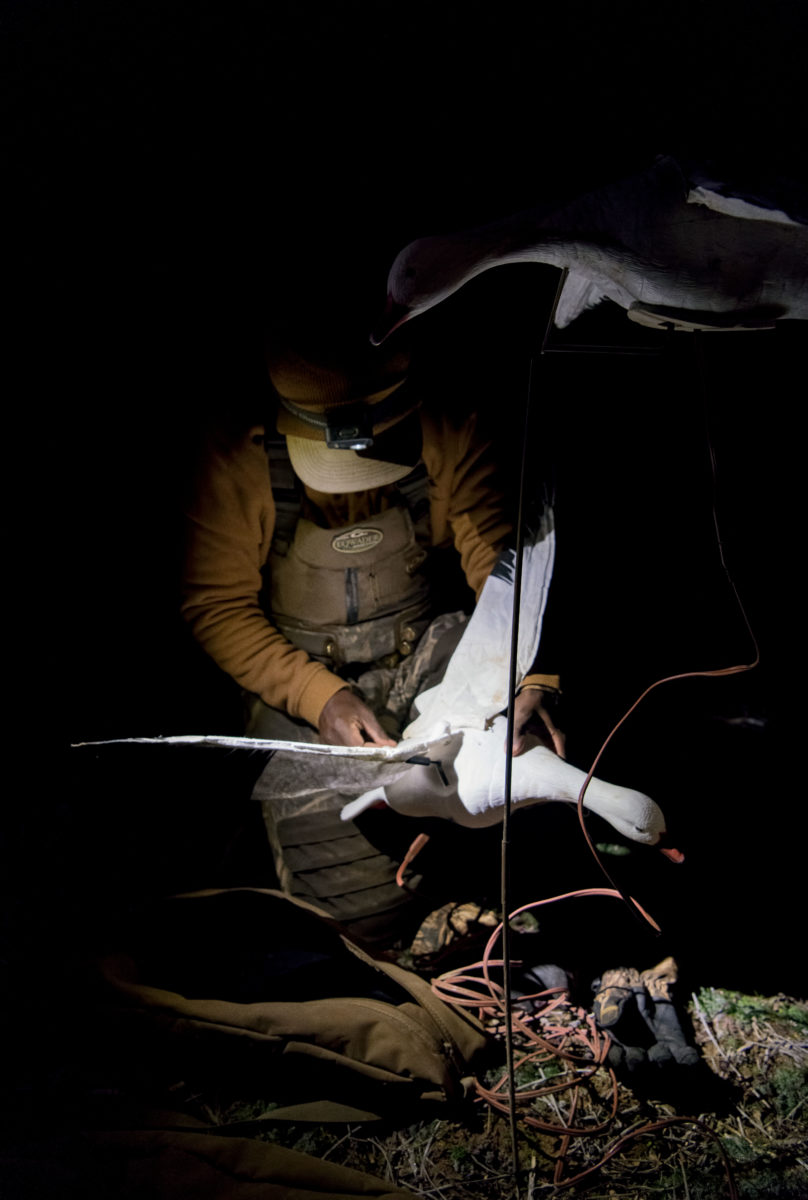
Photo: Andrew Hyslop
Jocelyn McNair assembles one of the decoys.
To call Wilkins a L’Amour-style Renaissance man is not a stretch. Over the course of preparing the evening’s meal, he offers an eloquent discourse that is a gumbo unto itself—Creole and West African culinary influences blend with racial justice melting into hunting and fishing history garnished with musical legend Louis Jordan, who lived down the street from what is now Black Duck Revival, before finishing with the virtues of frying a gas station honey bun in butter. Throughout, Wilkins returns to his gospel of self-reliance and our connection to nature. “I’m not saying a guided duck hunt is life changing, but being able to cook for people, or clear a drain, install a faucet, or change a lock—knowing how to do those things means you don’t need the money to give someone else. Cooking, baking, doing with your hands, is an art that feeds itself. There is a romance and beauty and intention in making things. It just breeds style and gentleness. I think gentleness is underrated, especially in men.” Gumbo simmering to his satisfaction, he finishes making chocolate icing, pours it over a fresh-baked chocolate cake, looks up over his COVID mask, and says, “Dude, I love a Bundt.”
Hunting snow geese is immersive. At daybreak, clouds press heavy upon the horizon. The saturated earth pushes back against days of rain, reducing everything to frozen mud. Wilkins advised all hunters to bring waders, not for water, but for insulation against the damp cold of the ground. Before first shooting light, we step into white zip-up Tyvek jumpsuits and lie down amid the socks and silhouettes at the apex of our massive decoy flock. We are embedded among the decoys in mud and nylon and neoprene and Tyvek. We are the decoys. To the west, the sound of geese awakening and lifting off the roost swells to a roar.
Even amid a group of hunters, you feel somewhat alone hunting snow geese, especially during a conservation hunt, a product of the 1999 Arctic Tundra Habitat Emergency Conservation Act, intended to reduce the ever-increasing snow, Ross’s, and blue goose populations to protect critical waterfowl nesting habitat for other species. Regulations are loosened; there are no bag limits and no proscriptions on unplugged guns or electronic calls. You lie back upon a metal ramp, staring at the sky. Earplugs protect your hearing from adjacent shotguns and your sanity from hours of squawking and honking from the speakers deployed around you. You can hear very little; you see only gray sky above.
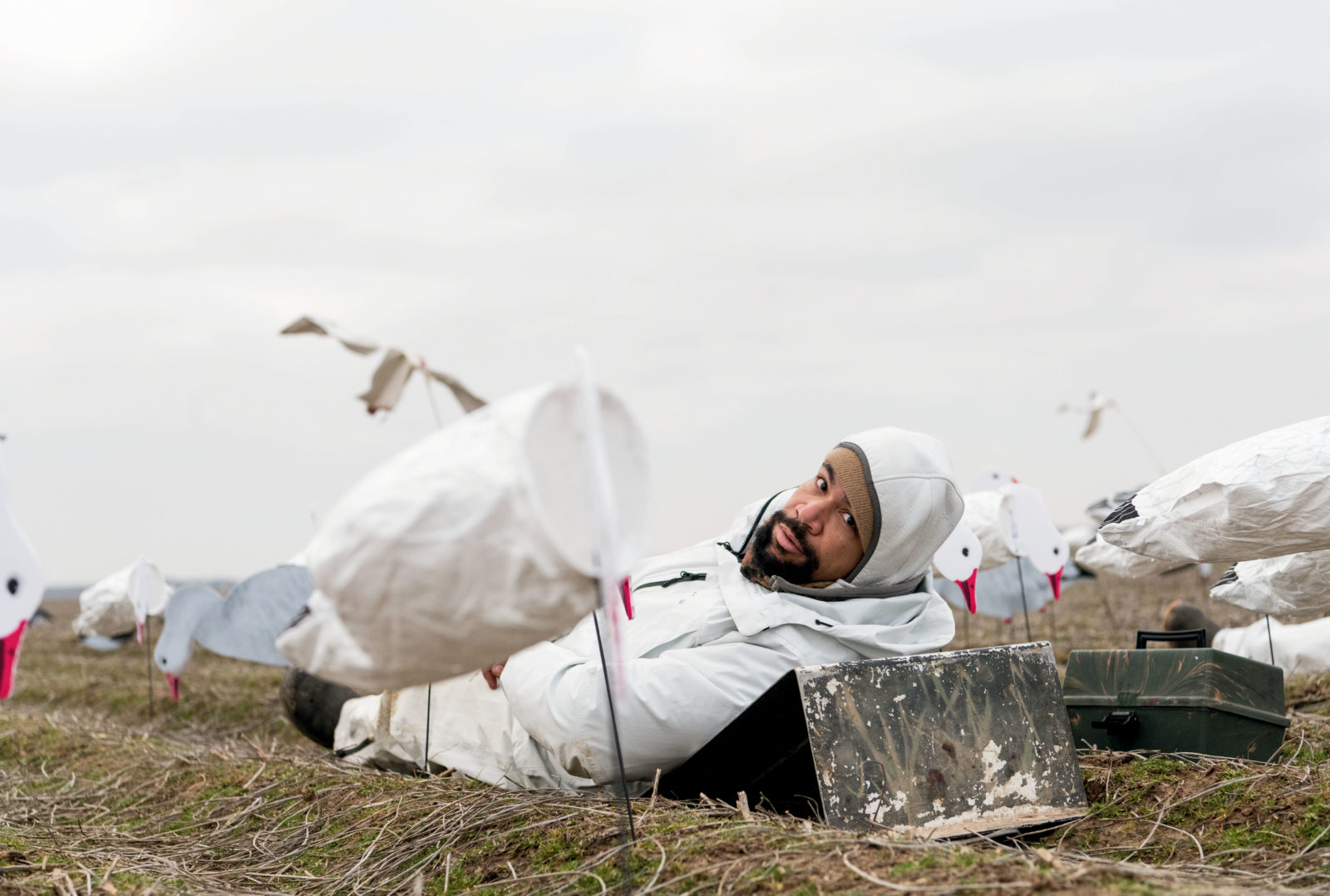
Photo: Andrew Hyslop
Each hunter lies on a ramp, facing up.
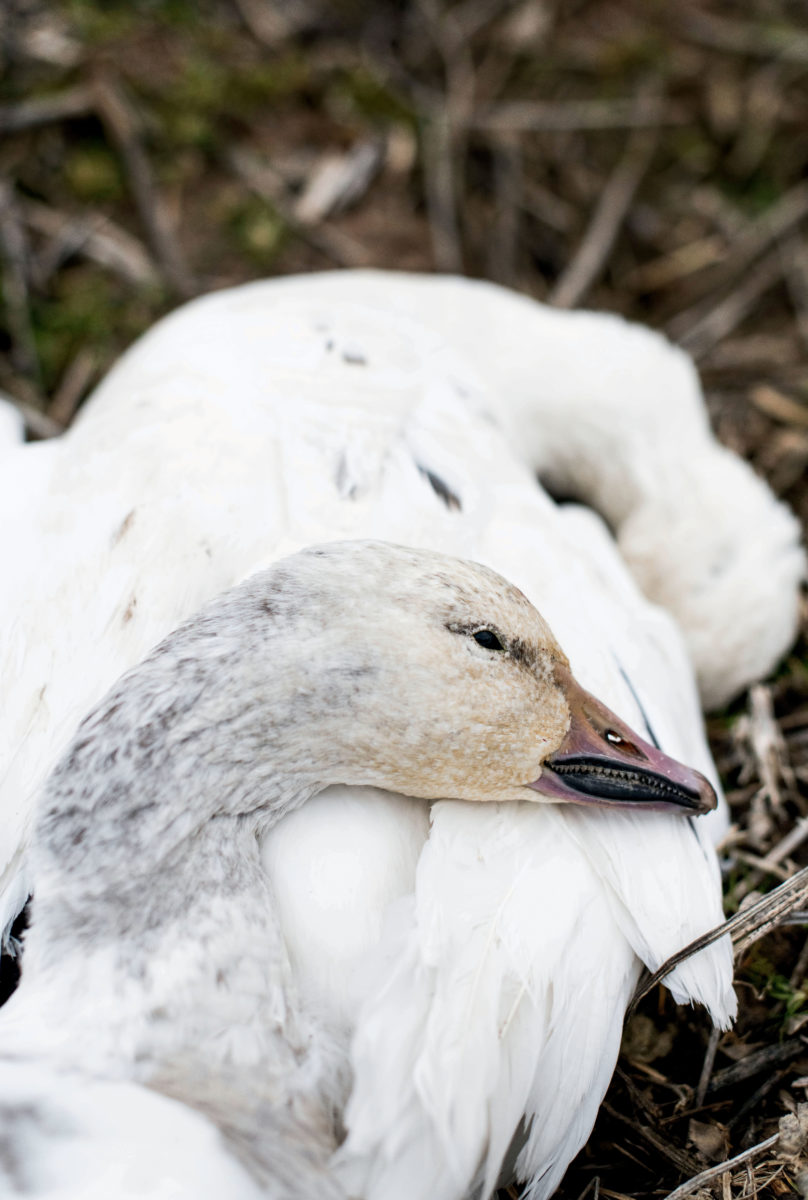
Photo: Andrew Hyslop
Geese on the ground.
Suddenly a pair of specklebelly geese, scouts a week out of season, fly low and loud with the insouciance of combat veterans returning from war. They dump air, dropping toward us, then both do a full-body double take as they finally see us. Much higher than the specks, well out of range of #2 shot, thousands of snow geese suddenly materialize in sinuous, fractal Vs. Formations intersect, absorb one another, gracefully writhe as one, then break apart to repeat the process. They call, high-low, high-low, a constant backbeat to the specks’ bugle. Like the decoys, the scale of the formations filling the sky is hard to comprehend. And then they are gone. More will come, but the marquee event happens just after first light, when the geese come off the roost—an event felt as much as seen or heard, akin to nervousness, something like anticipation, but neither. It is an overwhelming appreciation for being alive, and aware, and here, a deep appreciation of the now. It is the gift bestowed upon hunters by the wind and the moon and most of all, the birds.
When a snow goose deigns to come into range of our guns, it feels almost anticlimactic. The guns speak and a bird rag doll plummets. Once the sky is clear, Wilkins is on the move, recovering the fallen bird and suggesting everyone stand up and shake off the damp. When not actively watching the sky, Wilkins’s hunters are engaged in his passion for the birds. He gives a class on snow goose biology: how they age, how they see, how they roost, and what it takes to hunt them. Conventional wisdom holds that you must persuade only a few specklebelly geese in a flock to commit. With snows you have to “finish the flock,” convincing the first bird, all the birds in the middle, and the final bird in the flight that this field, 1,300 feet below them, is where they should feed.
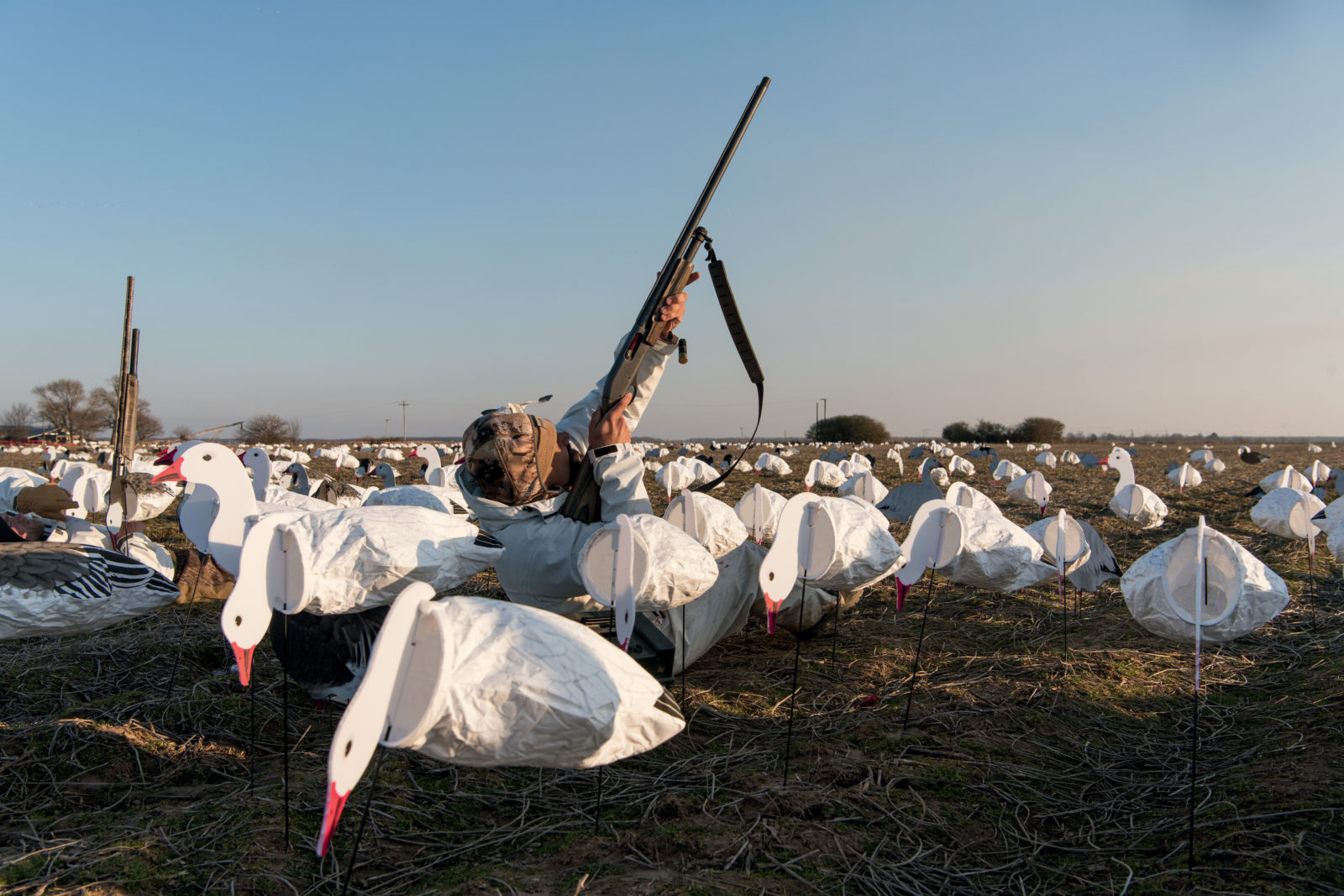
Photo: Andrew Hyslop
Wilkins takes aim.
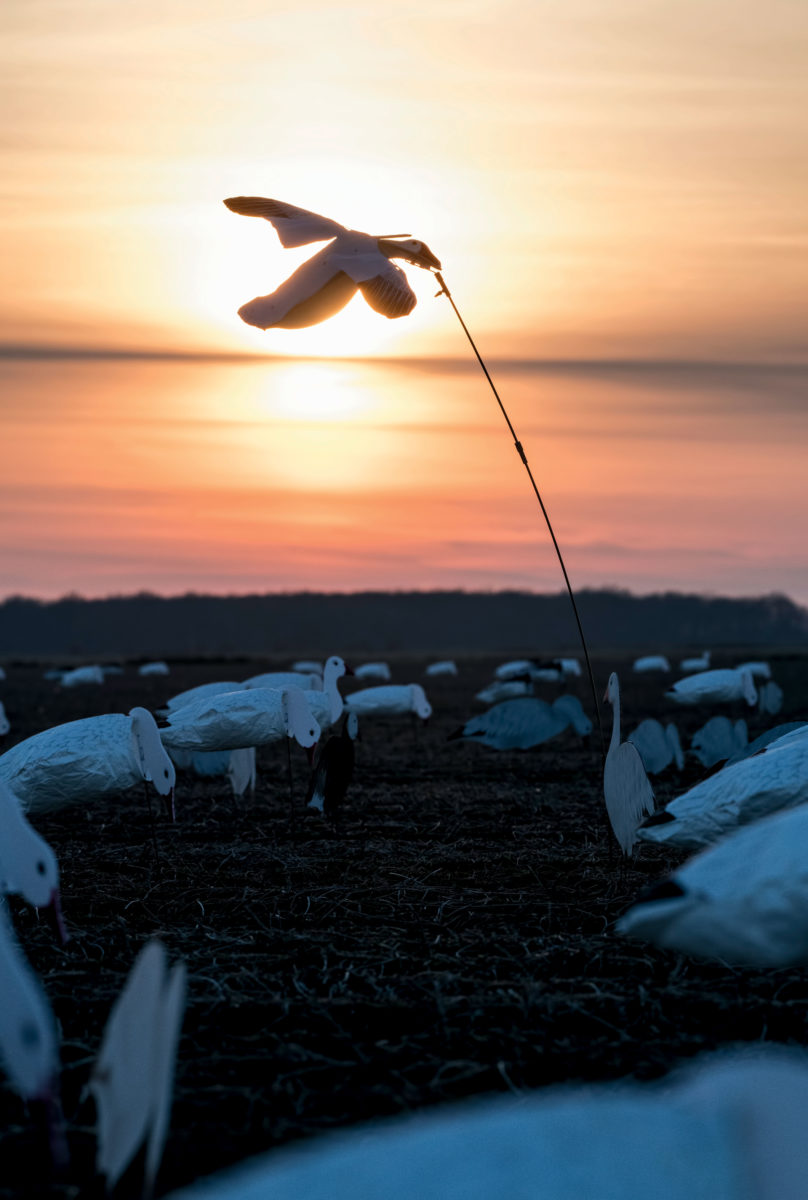
Photo: Andrew Hyslop
Sunrise over the decoy field.
Despite the morning’s Herculean decoy efforts, they are apparently unconvinced, and Wilkins recommends we get breakfast, then return in the afternoon. As we caravan through the crosshatch of Arkansas farmland, we see what we came for, albeit from our trucks rather than descending upon us like avenging Valkyries. Thousands of snows in a maelstrom of choreography only they understand, lifting and settling, shifting, feeding. And calling, always calling. It feels like chasing a tornado.
Returning after steel-cut oats, yogurt, and freshly baked cinnamon apples, we resume watch on the sky. The snows are only moderately more cooperative; three young birds join our count before we turn to recovering three thousand decoys. An hour into it, a member of the outfitter crew notes, “You earn every one of them, that’s for sure.”
Undeterred by the work and the cold and the previous day’s glorious frustration of watching thousands of birds fly high above us, we’re back at 5:17 the next morning, happily laying out decoys by the glow of our headlamps. The day is much like the preceding one. We see thousands of geese. A few cooperate, and we add them to our take. But there is more learning to be done, and as the hunting is slow, Wilkins recommends we head back to clean the birds.
Wilkins’s focus on snow goose hunts is partially reflective of the state of things for Arkansas hunting guides, partially his read of the market. In a state often associated with legendary private duck camps and wealthy clientele, Wilkins is a passionate public lands advocate. He is a state board member for the Arkansas chapter of Backcountry Hunters & Anglers, America’s foremost voice for public lands. Guiding on Arkansas’s public land is illegal, and Wilkins says that even if you have access to private land, “duck guiding in Arkansas is pugilistic.” Despite that, he has secured access to private land where he can provide traditional flooded timber duck, specklebelly, and snow goose hunts, but he also leads “alternative methods” bayou fishing trips, running limb lines and trotlines for catfish while bird-watching. He is as creative as he is dedicated, and it shows in experiences such as a combination goose hunt and whole-hog processing and pit barbecuing clinic taught by the culinary historian Adrian Miller and Scott Giltner, a professor of history at Culver-Stockton College in Missouri. “Specialization only works if you have the place to do it,” Wilkins says. “Instead of putting all your eggs in one basket, it’s diversity. People enjoy themselves more and see cool stuff.”
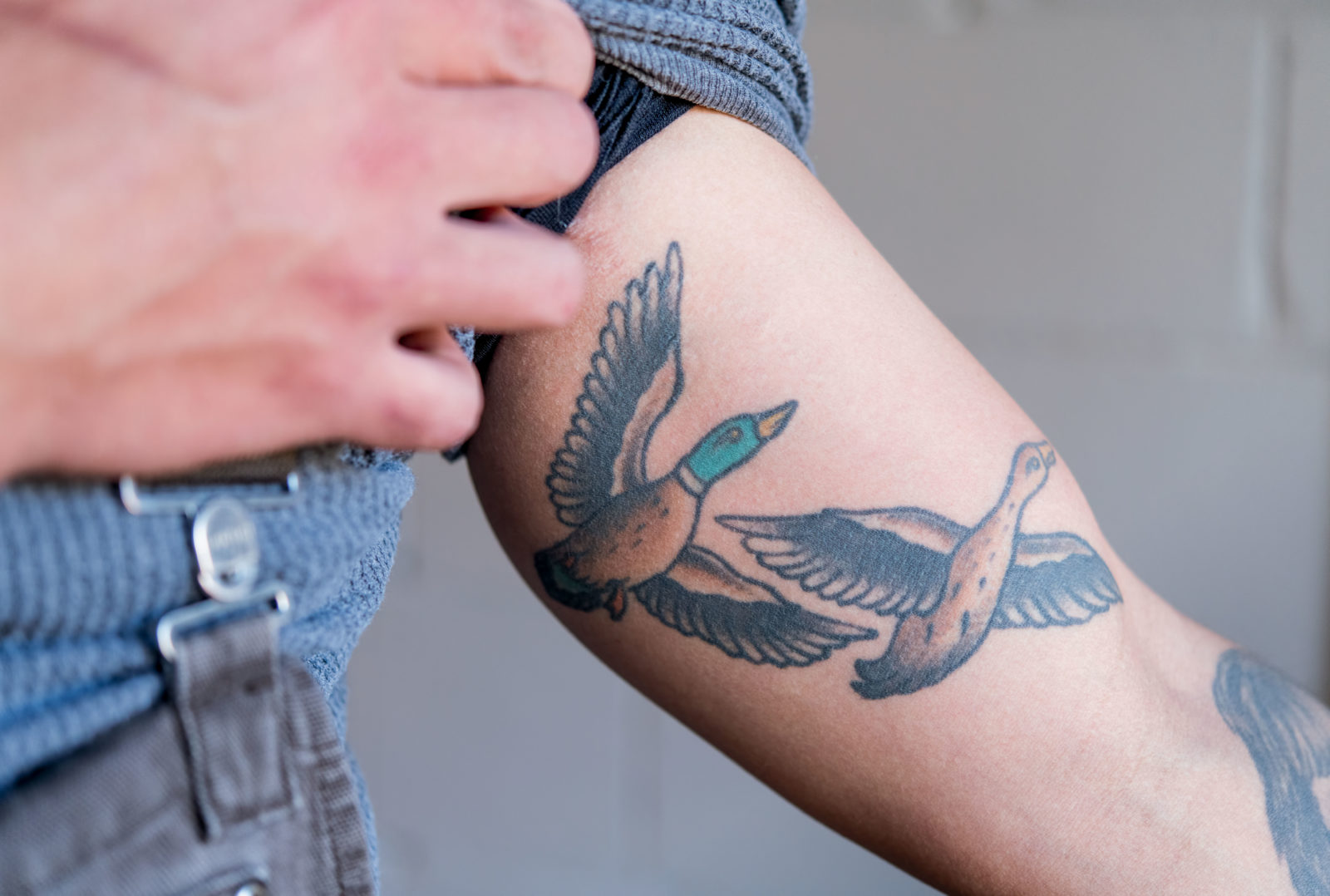
Photo: Andrew Hyslop
Waterfowl tattoos on Wilkins’s arm.
Black Duck Revival sleeps twelve people in the single- and double-occupancy rooms arranged around a central gathering, dining, and cooking space in the former sanctuary and in Black Duck Bungalow, but Wilkins prefers to keep guests at ten or fewer, to better allow for “active participants.” Our group reflects that ethos. It leads to something special at 728 North New York, something more meaningful than good food and comfortable beds. Spending a few days at Black Duck Revival awakens something that exists in every human: pleasure in the ability to provide. In the environment Wilkins very intentionally creates, that commonality attracts and coalesces a diverse assemblage of hunters from across the United States. Rue Mapp is the founder and CEO of Outdoor Afro, a nonprofit she built from a blog intended to encourage more Black Americans to spend time in the outdoors to a national network with nearly fifty thousand participants. She came from Oakland, California, to hunt at Black Duck Revival because, she says, “authenticity is what people need right now.”
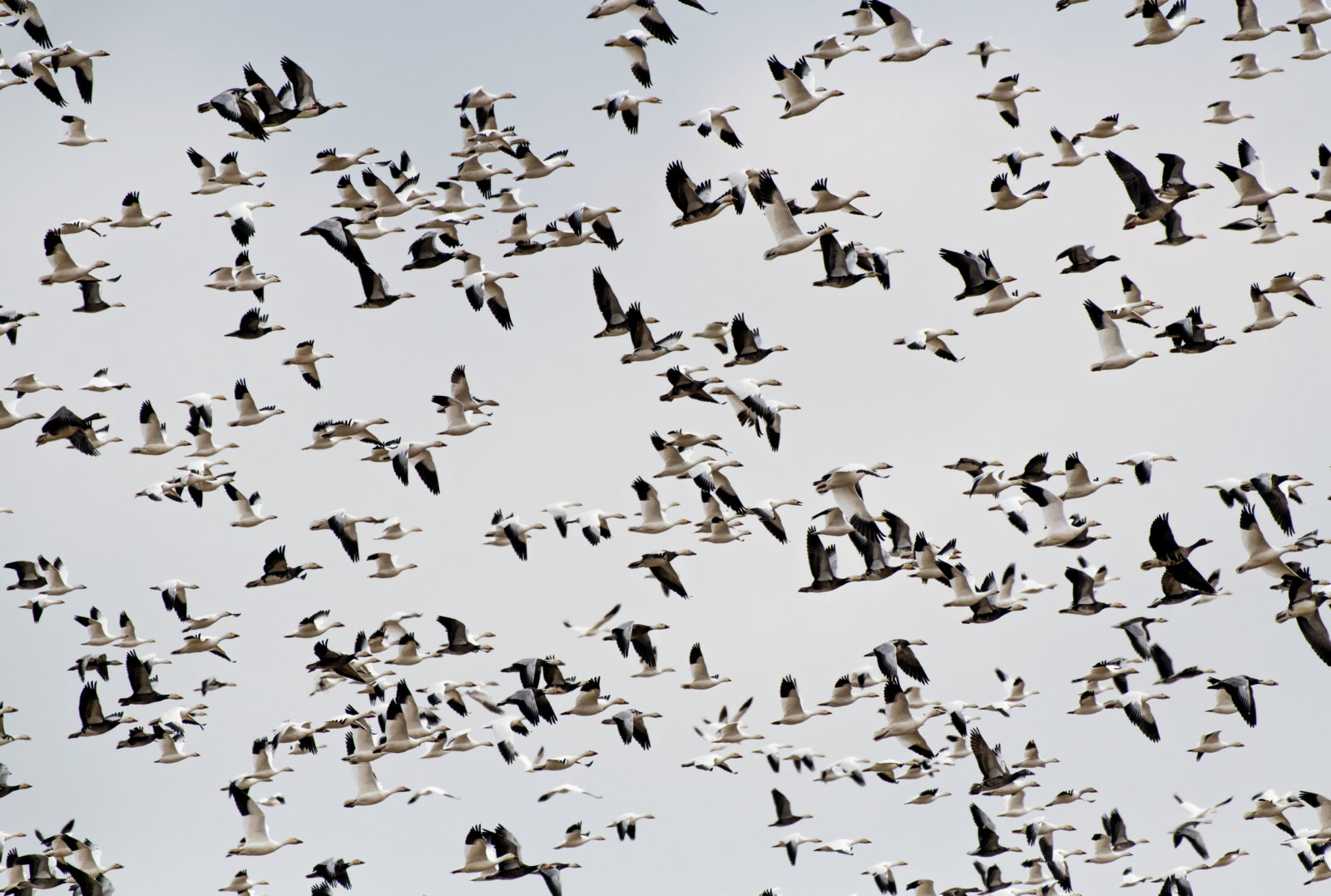
Photo: Andrew Hyslop
A flock of geese fills the sky.
In the evenings, we gather for dinner in repurposed church pews. We look little like the Fish & Wildlife survey hunters—a mix of men and women, rural and urban dwellers, three of us Black, three white. Over a common table and a common love of wild places, conversations both difficult and illuminating occur, starting with stories of previous hunts and wild game recipes but ending with frank discussions about breaking down misperceptions people hold about one another and obstacles to participation for nontraditional hunters. The Black Duck Revival beer, a Vienna lager brewed with foraged acorns by Legacy Wine and Spirits in Little Rock, goes down easily as Jocelyn McNair, an ardent hunter who happens to be gay, Black, and Pentecostal, offers, “If hunting as a system is not more advantageous for minorities—if the system doesn’t want you to be in it—there’s no reason to be part of it.” But she also extends the same grace Wilkins preaches, offering to meet her fellow hunters where they are. “I’m an army officer, I’m a vet, I’ve deployed, I’m a Sitka-wearing duck hunter,” she says. “You can fit me in a box that’s comfortable for you if you need to.”
Wilkins sees the conversations that develop around his table as fundamental to the spirit of Black Duck Revival. “What other hunting lodge do you know where a gay Black woman would feel comfortable coming in and sticking a Christmas card of her wife and child on the refrigerator the first night?” he says. “That’s the table I’m trying to build, and it seems like there are a lot of people who are beginning to feel comfortable sitting there.”
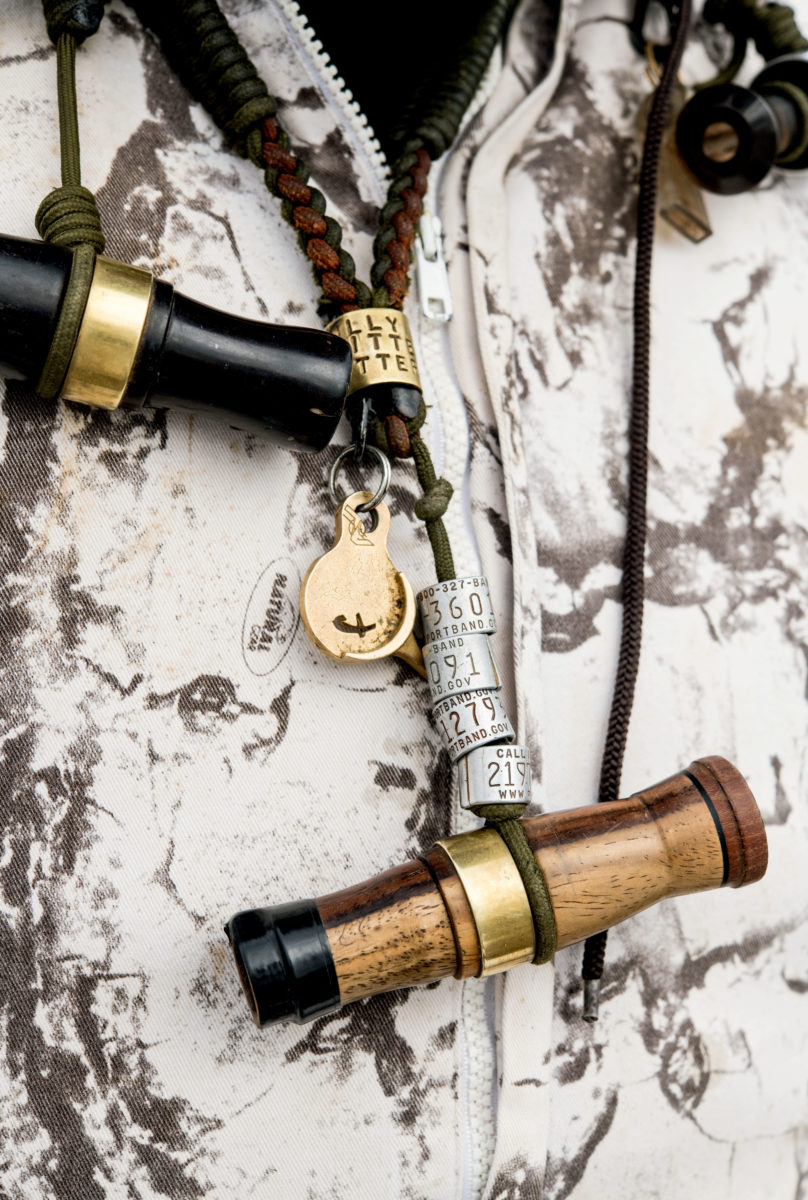
Photo: Andrew Hyslop
Calls and goose bands.
The hunting industry is taking notice. Recruiting and retaining new hunters or reawakening those currently dormant is critical to the survival of the tradition and the industry it supports. Wilkins represents an avenue to an emerging market. “Man, see, when you look at hunting and how it’s changing, how people are seeking organic and authentic food sources, and then consider how people are constructing strife for their lives, like, making a CrossFit version of life—hunting is authentic.” Recognizing that with industry attention comes “an opportunity for tokenization,” Wilkins asks of every opportunity whether it is authentic to him. “When I try to force myself into a space not meant for me, it never works. As I’ve gotten more attention from the hunting community and industry, they offer me a seat at the table. But the table wasn’t built for me. It was built for the people who have always been there. I have to build my own table. It may be smaller, but that’s okay. Man, you know, one of the things I really respect about the South is that Southerners made their own table.”
In a world of “pro-staff deals” and “social media influencers,” he pays a price for that autonomy. “I enjoy Black Duck Revival so much, I want it to be the main thing,” he says. “But at the end of the season, I’ll be mowing lawns, landscaping, and doing carpentry to bring in money.”
After our second morning afield, each hunter has at least one snow goose from which to learn the lessons Wilkins wants to impart. With our bellies full of burritos stuffed with fluffy eggs, sausage, and peppers; fresh fruit; and hot cinnamon-topped blueberry muffins, Wilkins leads us in cleaning our geese.
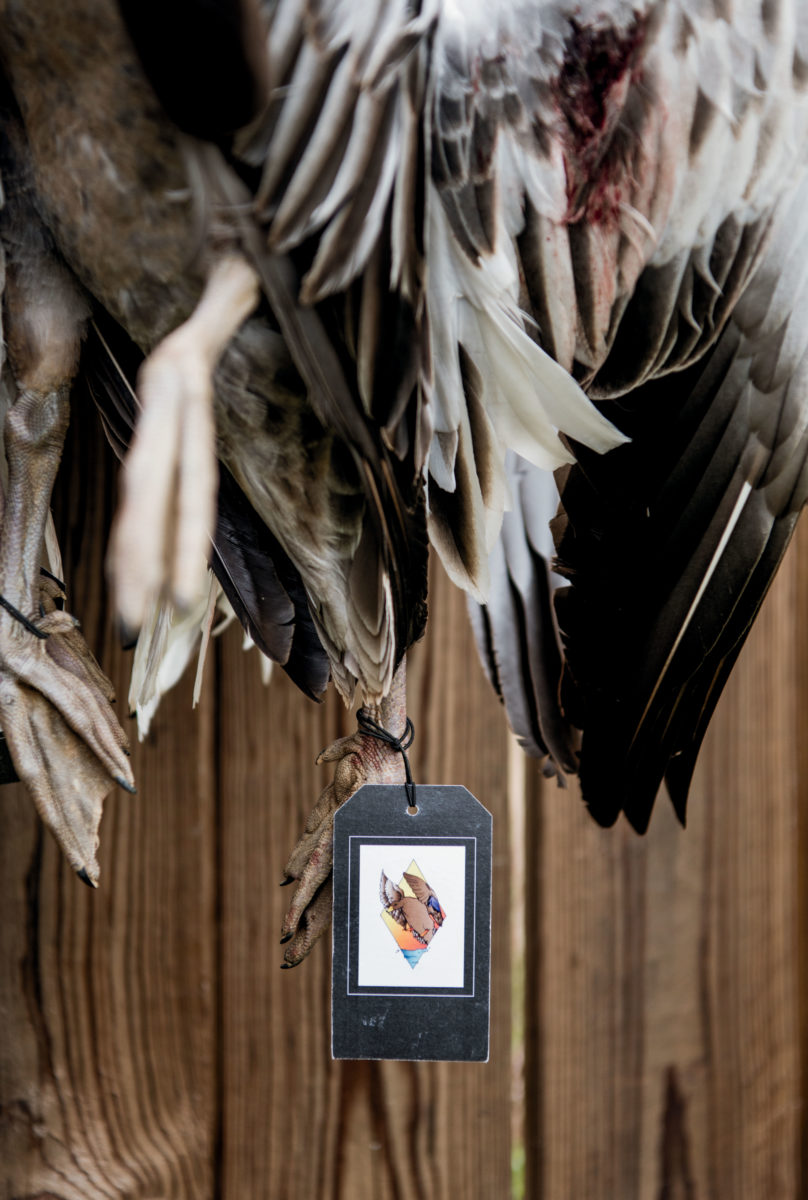
Photo: Andrew Hyslop
Birds ready for cleaning.
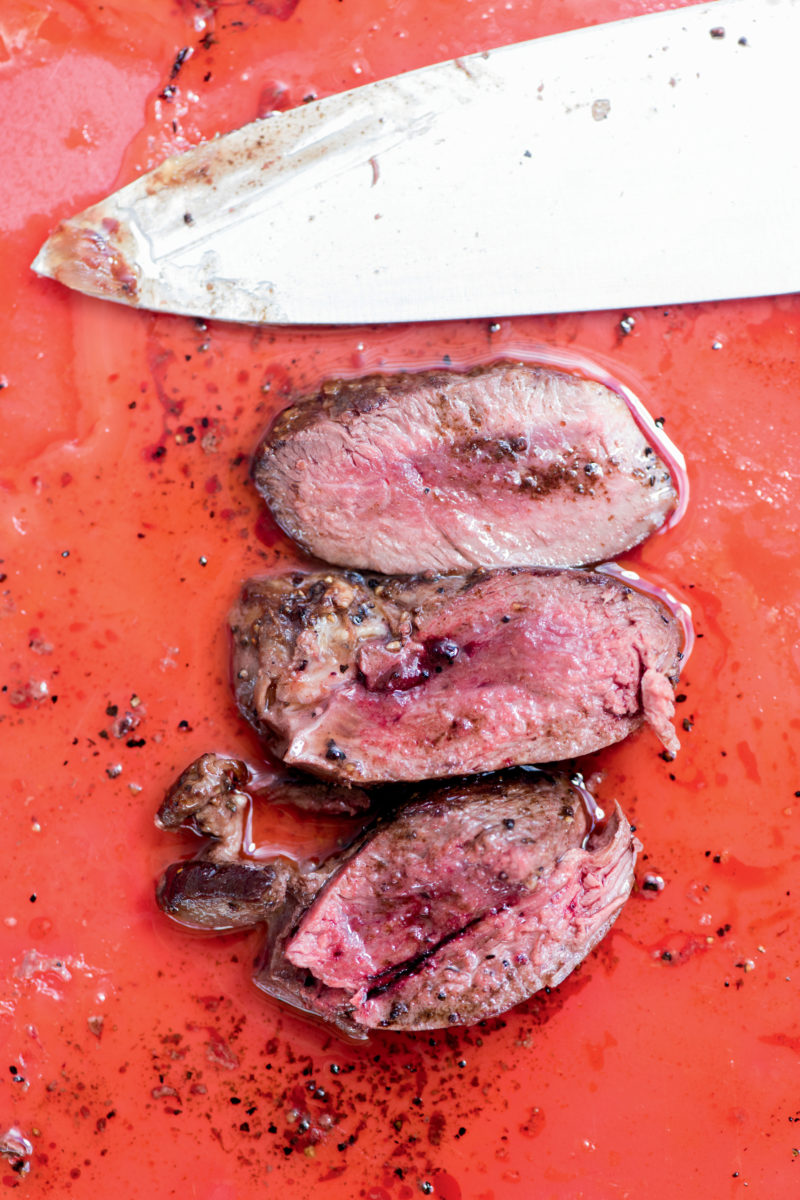
Photo: Andrew Hyslop
Pan-seared goose breast.
He’s passionate about sustainability and the use of the whole bird to “rewrite the experience,” and he decries the focus on shooting a limit of birds. “Studies have shown that hunter satisfaction goes up when limits go down. Now that the term is in vogue, people are focused on limiting—it’s the number, not the experience.” But if you conceptualize the entire animal as food, he says, you are no longer worried about “limiting” because there’s enough to one snow goose to feed a family of four. Wilkins peels back the thin skin that covers a snow goose breast and expands. “You can smoke the wings. You can braise down the thighs to make a confit. The breast is a steak as good as any you will eat, and under that breast is a tender. The gizzard, the heart, and the liver are phenomenal for sausage or to make pâté or dirty rice.” As he speaks, he skewers six goose hearts and places them over an open fire. He picks up the feet. “Wash these well, and you can cook them down into some of the richest stock you will ever have in your kitchen. You can make four high-quality, meaningful meals for your family out of a single Ross’s or a snow or a speck. They’re such cool birds!” As we eat flame-kissed hearts and rare goose breast, salted and peppered and turned twice in a pan, we enthusiastically agree.

Photo: Andrew Hyslop
The main Black Duck Revival building in Brinkley.
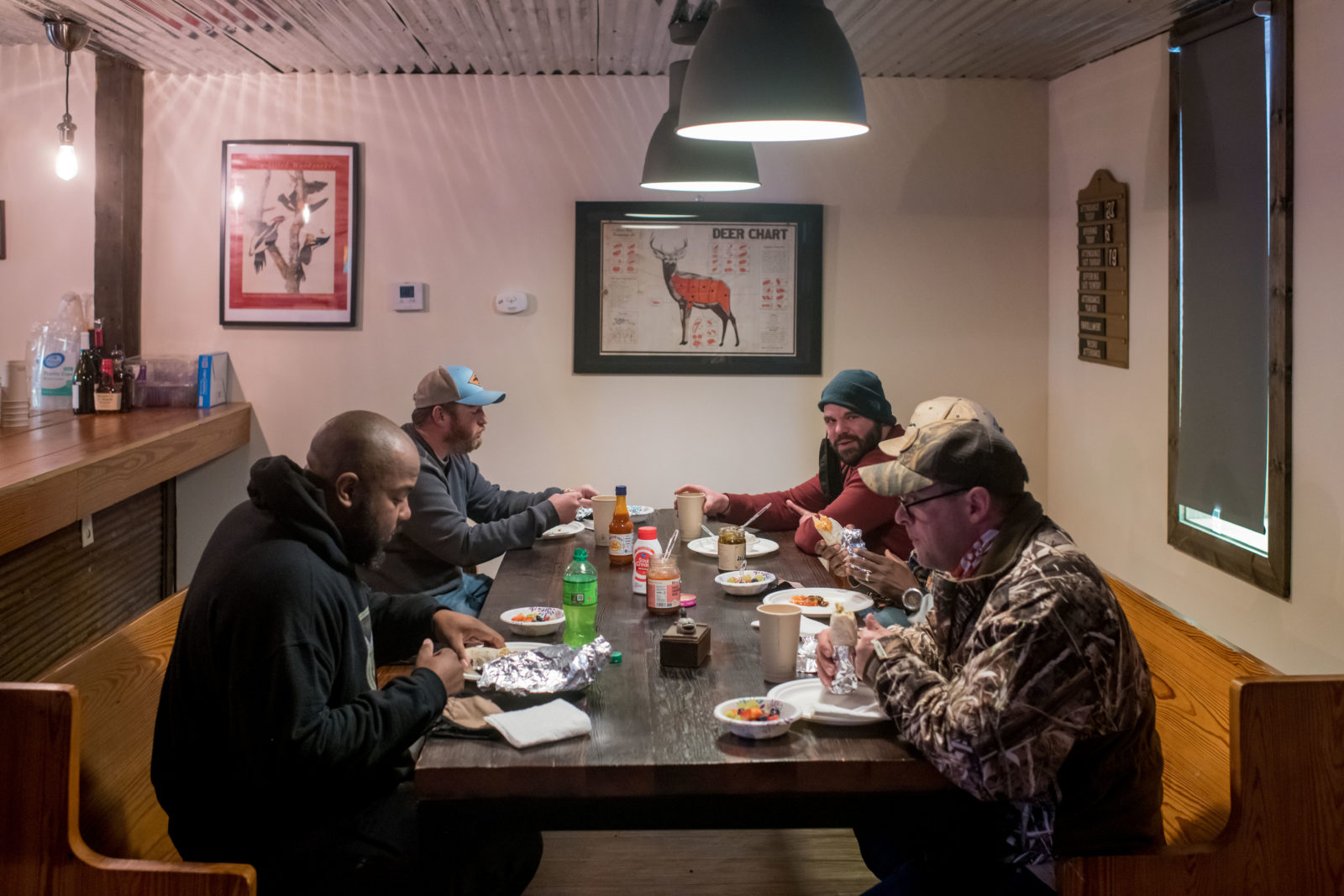
Photo: Andrew Hyslop
Post-hunt breakfast burritos.
There is a summer camp aspect to departing Black Duck Revival. We arrived as hunters. Forty-eight hours later, we leave as friends. Six very different hunters exchange hugs and emails and cell numbers. For days afterward, we email one another and post pictures on social media uniformly expressing the hope that the spirit that moved us all at Black Duck Revival will remain. That optimism may be the most important, and lasting, aspect of Jonathan Wilkins’s pursuit of our common authenticity and self-reliance in wild places. Maybe a hunt can be life changing. “Don’t denigrate or diminish what we’re doing here,” says Jocelyn McNair as we reflect on our time together. “Because a thousand micros can be a macro.”


